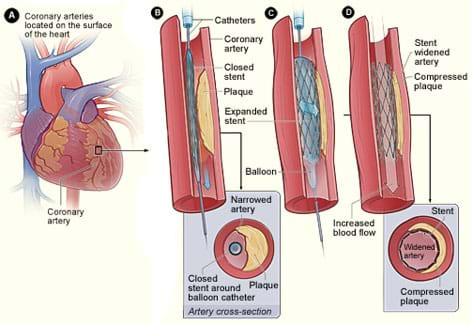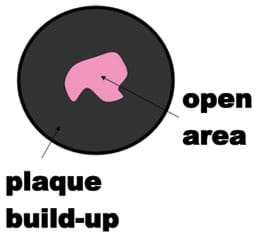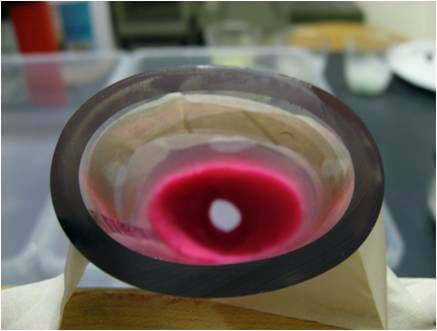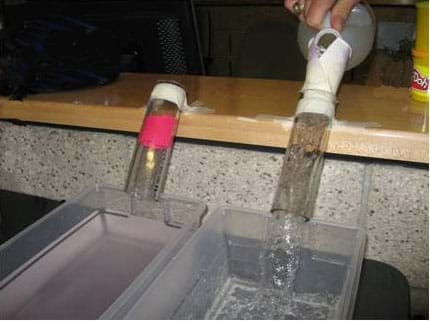Summary
Following the steps of the engineering design process and acting as biomedical engineers, student teams use everyday materials to design and develop devices and approaches to unclog blood vessels. Through this open-ended design project, they learn about the circulatory system, biomedical engineering, and conditions that lead to heart attacks and strokes.
Engineering Connection
Engineers of all types—biomedical, mechanical, chemical, electrical, materials, computer—work together with medical professionals to apply basic biological and medical science to solving real-world problems. Devices such as catheters, balloon catheters and stents help people avoid or live beyond life-threatening heart attacks and strokes.
Learning Objectives
After this activity, students should be able to:
- Describe what happens when a blood vessel is blocked.
- Describe how bioengineering techniques can be used to "open up" a blocked blood vessel.
- Apply the engineering design process to create solutions to a problem.
Educational Standards
Each TeachEngineering lesson or activity is correlated to one or more K-12 science,
technology, engineering or math (STEM) educational standards.
All 100,000+ K-12 STEM standards covered in TeachEngineering are collected, maintained and packaged by the Achievement Standards Network (ASN),
a project of D2L (www.achievementstandards.org).
In the ASN, standards are hierarchically structured: first by source; e.g., by state; within source by type; e.g., science or mathematics;
within type by subtype, then by grade, etc.
Each TeachEngineering lesson or activity is correlated to one or more K-12 science, technology, engineering or math (STEM) educational standards.
All 100,000+ K-12 STEM standards covered in TeachEngineering are collected, maintained and packaged by the Achievement Standards Network (ASN), a project of D2L (www.achievementstandards.org).
In the ASN, standards are hierarchically structured: first by source; e.g., by state; within source by type; e.g., science or mathematics; within type by subtype, then by grade, etc.
NGSS: Next Generation Science Standards - Science
| NGSS Performance Expectation | ||
|---|---|---|
|
MS-ETS1-1. Define the criteria and constraints of a design problem with sufficient precision to ensure a successful solution, taking into account relevant scientific principles and potential impacts on people and the natural environment that may limit possible solutions. (Grades 6 - 8) Do you agree with this alignment? |
||
| Click to view other curriculum aligned to this Performance Expectation | ||
| This activity focuses on the following Three Dimensional Learning aspects of NGSS: | ||
| Science & Engineering Practices | Disciplinary Core Ideas | Crosscutting Concepts |
| Define a design problem that can be solved through the development of an object, tool, process or system and includes multiple criteria and constraints, including scientific knowledge that may limit possible solutions. Alignment agreement: | The more precisely a design task's criteria and constraints can be defined, the more likely it is that the designed solution will be successful. Specification of constraints includes consideration of scientific principles and other relevant knowledge that is likely to limit possible solutions. Alignment agreement: | All human activity draws on natural resources and has both short and long-term consequences, positive as well as negative, for the health of people and the natural environment. Alignment agreement: The uses of technologies and any limitations on their use are driven by individual or societal needs, desires, and values; by the findings of scientific research; and by differences in such factors as climate, natural resources, and economic conditions.Alignment agreement: |
| NGSS Performance Expectation | ||
|---|---|---|
|
MS-ETS1-2. Evaluate competing design solutions using a systematic process to determine how well they meet the criteria and constraints of the problem. (Grades 6 - 8) Do you agree with this alignment? |
||
| Click to view other curriculum aligned to this Performance Expectation | ||
| This activity focuses on the following Three Dimensional Learning aspects of NGSS: | ||
| Science & Engineering Practices | Disciplinary Core Ideas | Crosscutting Concepts |
| Evaluate competing design solutions based on jointly developed and agreed-upon design criteria. Alignment agreement: | There are systematic processes for evaluating solutions with respect to how well they meet the criteria and constraints of a problem. Alignment agreement: | |
| NGSS Performance Expectation | ||
|---|---|---|
|
MS-ETS1-4. Develop a model to generate data for iterative testing and modification of a proposed object, tool, or process such that an optimal design can be achieved. (Grades 6 - 8) Do you agree with this alignment? |
||
| Click to view other curriculum aligned to this Performance Expectation | ||
| This activity focuses on the following Three Dimensional Learning aspects of NGSS: | ||
| Science & Engineering Practices | Disciplinary Core Ideas | Crosscutting Concepts |
| Develop a model to generate data to test ideas about designed systems, including those representing inputs and outputs. Alignment agreement: | Models of all kinds are important for testing solutions. Alignment agreement: The iterative process of testing the most promising solutions and modifying what is proposed on the basis of the test results leads to greater refinement and ultimately to an optimal solution.Alignment agreement: | |
Common Core State Standards - Math
-
Fluently add, subtract, multiply, and divide multi-digit decimals using the standard algorithm for each operation.
(Grade
6)
More Details
Do you agree with this alignment?
-
Fluently divide multi-digit numbers using the standard algorithm.
(Grade
6)
More Details
Do you agree with this alignment?
International Technology and Engineering Educators Association - Technology
-
Students will develop an understanding of the attributes of design.
(Grades
K -
12)
More Details
Do you agree with this alignment?
-
Students will develop an understanding of engineering design.
(Grades
K -
12)
More Details
Do you agree with this alignment?
-
Students will develop abilities to apply the design process.
(Grades
K -
12)
More Details
Do you agree with this alignment?
-
Advances and innovations in medical technologies are used to improve healthcare.
(Grades
6 -
8)
More Details
Do you agree with this alignment?
-
Make two-dimensional and three-dimensional representations of the designed solution.
(Grades
6 -
8)
More Details
Do you agree with this alignment?
State Standards
Colorado - Math
-
Fluently divide multi-digit numbers using standard algorithms.
(Grade
6)
More Details
Do you agree with this alignment?
-
Fluently add, subtract, multiply, and divide multidigit decimals using standard algorithms for each operation.
(Grade
6)
More Details
Do you agree with this alignment?
Colorado - Science
-
Develop and design a scientific investigation about human body systems
(Grade
7)
More Details
Do you agree with this alignment?
-
Gather, analyze, and interpret data and models on the functions and interactions of the human body
(Grade
7)
More Details
Do you agree with this alignment?
Materials List
Each group needs:
- 2 model "blocked arteries" made from about 4 inches (10 cm) of flexible tubing (~1.5-in [3.8-cm] diameter) clogged with play dough (or peanut butter); alternatively, use PVC pipe instead of tubing
- 2 clown balloons (long and thin)
- air pump, for clown balloons
- 2 straws
- 2 paper clips
- thin wire
- 1 pipe cleaner
- 4 rubber bands
- tape
- 1 square of aluminum foil, about 3 x 3 inches [7.6 x 7.6 cm]
- (optional) strip of metal mesh screen, about 4 x 1 inch [10 x 2.54cm]
- Clearing Blocked Arteries Measurements Worksheet, one per student
For the entire class to share:
- water source
- 2 liter container (from which to pour the same amount of water)
- large jug, bin or container, to catch poured water
- timer (such as the classroom clock with second hand or a person's watch or phone)
- Three Treatment Methods Images, an overhead projector transparency or printouts to show students

Worksheets and Attachments
Visit [www.teachengineering.org/activities/view/cub_biomed_lesson03_activity1] to print or download.Pre-Req Knowledge
A basic knowledge of the human circulatory system, blood flow and artery clearing, as provided by the associated lesson, Body Circulation.
Introduction/Motivation
In 2003, a 14 year old boy in China experienced severe chest pain during exercise. At the hospital, doctors found that he had a clogged artery, and if they were not able to clear it, he would go into cardiac arrest and experience heart failure. Luckily, the doctors were able to use an engineered stent to open his artery and prevent heart failure.
Do you know anyone who has had a heart attack? (Ask students to raise their hands.) Do you think that heart attacks are common? Why or why not? What causes them?
In a properly working human circulatory system, blood vessels are clean and smooth (like clean pipes). However, during the course of a lifetime, sometimes material coats the interior walls of blood vessels. This plaque, whether it hardens and stays in place, or hardens and gets dislodged, can have significant health consequences. Having material blocking the normal blood flow restricts the movement of blood, thus preventing sufficient nutrients and oxygen from reaching all parts of the body. Having plaque material moving though the blood vessels may also result in that material eventually encountering a smaller blood vessel and blocking any blood from going through, which prevents nutrients and oxygen from reaching everywhere they are needed. The problems this can cause are significant, problems such as heart attacks and strokes.
The best way to avoid these medical conditions is prevention via things like healthy eating and exercise. However, at the point when blockage is found, it must be treated to avoid health problems. Engineers and doctors have designed various ways to unclog or unblock plaque-coated blood vessels. That's what we're going to look at today—heart attack and stroke treatment and prevention. How exactly is blood flow restored to the heart when plaque, or a blood clot, is blocking blood flow? Every day biomedical, mechanical, chemical and electrical engineers (and others types, too) work with medical doctors to devise more effective treatments for heart attacks and strokes. Today, we are going to see if we can do the same.
What ideas do you have about how we might unclog a blocked artery? (Listen to and encourage student brainstorming and ideas.) Currently, three primary treatments for clogged arteries are in common use (optional; show students Three Methods to Treat Blocked Arteries as either an overhead transparency or printouts, depending on whether or not you want to show them these ideas or wait until activity end). The first two are types of angioplasty, or recreating of the canal in the blood vessel. The first method is a balloon catheter in which a small balloon is passed through the artery to the clogged area where it is inflated, compressing the plaque and opening the artery to greater flow. The second method is similar to the balloon catheter with the addition of a stent surrounding the balloon, so when the balloon inflates, the stent remains behind to keep the plaque pinned against the walls. The third method is a bypass surgery in which the blocked section of the artery is removed and the artery is reconnected, free of the blockage.
Procedure
Before the Activity
- Gather materials and make copies of the Clearing Blocked Arteries Measurements Worksheet, one per student.
- Make either an overhead projector transparency or printouts of the Three Treatment Methods Images.
- Make enough model blocked arteries to provide two per team. The representative artery/artery walls, made from either flexible rubber tubing or PVC pipe, are larger than the diameter of real human arteries, but serve as models for this open-ended design project. To simulate plaque buildup inside the model blocked arteries, use play dough or other material (such as peanut butter) that can be wedged inside but is still soft enough to be moved about when students test their device designs (see Figure 1).

With the Students: Design and Prototype
- Divide the class into groups of three students each. Hand out the worksheets.
- Demonstrate that blocked arteries have different flow than clear arteries by having the class time how long it takes for two liters of water to flow through a clear piece of piping at a 45° angle versus through a blocked piece of piping at the same angle (see Figure 2). Have students record these measurements on their worksheets.

- Explain the design project to the student teams: Your challenge today is to create a device that could remove or flatten the built-up plaque material inside artery walls. How are you going to go about doing this? What are the steps a design team of engineers would take? (After students have suggested ideas, write on the board the steps all engineers go through in designing and solving problems. These steps are referred to as the engineering design process. Understand the need, brainstorm ideas, design and plan, create and test a prototype, and review and improve.) Well, first engineers must have a problem or a need. Then, they brainstorm creative ideas and solutions to that problem or need. Next, they select the most promising idea and create a design that they can draw or communicate to others. They make a prototype of that design and test it to evaluate whether or not the design is successful.

- Continue with the project instructions: Today, you and your team are engineers working together to create a device that could remove or flatten the built-up plaque material inside artery walls. Your team has two identical blocked arteries and a set of materials. Use the materials to develop a device to improve the flow in the artery. Remember, you do not have to use all of the materials. The last step of the design process is to review and improve on your design. You have two model arteries to built, test and then redesign with improvements. Keep in mind that you do not want to just knock the plaque off the wall and leave it in the blood stream, and you do not want to hurt the fragile inside wall of the arteries.
- Ask students: What ideas do you have for how to unblock your model arteries? (As necessary, share the ideas that were mentioned during the Introduction/Motivation section of the activity, such as: dissolve the clot or blockage, use a balloon to push the artery open.)
- Direct students to brainstorm, design (create a drawing with labeled materials), create a prototype and test their designs. Expect the second design to be an improvement of the first.
- Circulate among the groups as they work, observing and asking questions, as provided in the Assessment section. As students are working, challenge them to think about what happens to the plaque they dislodge, move or scrape away. Remind them that we do not want the treatment to hurt the patient!
With the Students: Communication and Testing
- Have each team present a description of its two designs and design process to the class.
- Measure success by timing how fast 2 liters of water flow through a team's cleared arteries after the treatment method. Hold the arteries at 45° angle while the water flows. Have students record these measurements on their worksheets. Compare data. If desired, award prizes for the best team design.
- Have students complete the questions on their worksheets.
With the Students: Conclusion and Reflection
- Lead a class discussion:
- Our model blocked arteries are, of course, not real arteries. What challenges might an engineering team face when creating a similar technology for real arteries? (Possible answers: The real blocked arteries would be in a human body, so they would be hard to get to, slippery, walls might be more elastic, and the plaque would be different.)
- While the materials may not be the same, the process that you used to develop your prototype devices is the same used by engineers. And while their devices may be different, they share similarities to your solutions. (Show students the three images of current treatment methods.)
- Look carefully at the mechanics of the balloon catheter (angioplasty), coronary bypass surgery, and catheter with stent (angioplasty). What similarities and differences do you see?
Vocabulary/Definitions
balloon catheter: A catheter with an inflatable tip that can be expanded by the passage of gas or liquid; used especially to expand a partly closed or obstructed bodily passage or tube (such as an artery). Also called balloon-tipped catheter.
bioengineering: The use of artificial tissues, organs or organ components to replace damaged or absent body parts, such as artificial limbs and heart pacemakers. Source: The Oxford Pocket Dictionary of Current English, http://encyclopedia.com/doc/1O999-bioengineering.html
biomedical engineer: A person who blends traditional engineering techniques with the biological sciences and medicine to improve the quality of human health and life. Biomedical engineers design artificial body parts, medical devices, diagnostic tools and medical treatment methods.
brainstorming: A method of shared problem solving in which all members of a group contribute many ideas.
catheter: A hollow, flexible tube for insertion into a body cavity, duct or vessel to allow the passage of fluids or expand a passageway.
coronary artery bypass surgery: A surgery that uses a piece of a vein from the leg, or artery from the chest or wrist. The surgeon attaches this to the coronary artery above and below the narrowed area or blockage so blood can bypass the blockage. Some people need more than one bypass. Source: Medline Plus, US National Library of Medicine and National Institutes of Health: http://www.nlm.nih.gov/medlineplus/coronaryarterybypasssurgery.html
engineer: A person who applies an understanding of science and math to creating things for the benefit of humanity and our world.
engineering design process: A decision-making process used by engineers to make something that meets a need or solves a problem. Steps include: brainstorm, design, plan, create, test, improve.
heart attack: Damage to heart muscle that is deprived of oxygen via blood flow, usually due to blockage of a coronary artery. Typically accompanied by chest pain. Often life threatening. Also called myocardial infarction.
model: (noun) A representation of something, sometimes on a different scale. (verb) To simulate, make or construct something to help visualize or learn about something else (such as a living human body, process or system) that cannot be directly observed or experimented upon.
plaque: A deposit of fatty material on the inner lining of an arterial wall.
prototype: A first attempt or early model of a new product, device or creation. Typically revised many times.
stent: A small, expandable tube used for inserting in a blocked vessel.
stroke: When a blockage of a blood vessel to the brain causes inadequate oxygen supply, leading to weakness, paralysis, speech difficulties, loss of consciousness and/or death.
Assessment
Pre-Activity Assessment
Brainstorming: Have students brainstorm different possible ways a clogged artery might be cleared without harming the patient. Do this before explaining current practices. Remind students that brainstorming is the time to be very creative. During brainstorming, no idea or suggestion is "wrong" or "ridiculous." Respectfully listen to all ideas and build on them.
Activity Embedded Assessment
Design Process: Visit each group and ask the following questions, depending on the team's stage in the design process:
- Why did your group decide on this design?
- How does this device work?
- What happens to the plaque after you use the device?
- Which specific blood vessel in the body might this represent?
- What would happen if you were able to unblock part, but not all, of the artery?
- How would having partially blocked blood vessels affect a person's body?
Worksheet: Have students complete the activity worksheet; review their answers to gauge their understanding of the subject.
Post-Activity Assessment
Communicating the Results: Have student teams present their designs to the class. Have them share why they chose that design, what worked, what did not work, and ways in which the design might be improved.
Troubleshooting Tips
Make sure students create feasible solutions, for example, make sure their devices fit into the tubes and have a way of removing or flattening the plaque.
Make sure teams incorporate "lessons learned" from their first design/test as they create revised and improved second designs.
Activity Extensions
So that the model designs are more lifelike, have students create catheter devices that could be used while water is flowing through the system.
Have teams create engineering presentations that they would give to manufacturing companies, hospitals or medical personnel highlighting the benefits of their particular medical devices.
Activity Scaling
- For upper grades, do not show them current treatment methods until after they have completed the activity.
Additional Multimedia Support
See a good drawing of coronary balloon angioplasty at this National Institutes of Health website: http://www.nhlbi.nih.gov/health/dci/Diseases/Angioplasty/Angioplasty_howdone.html
Subscribe
Get the inside scoop on all things TeachEngineering such as new site features, curriculum updates, video releases, and more by signing up for our newsletter!More Curriculum Like This

Students are introduced to the circulatory system with an emphasis on the blood clotting process, including coagulation and the formation and degradation of polymers through their underlying atomic properties. They learn about the medical emergency of strokes—the loss of brain function commonly due ...

Students make a proportional model of blood out of red gelatin, a plastic bag, and rice. They learn about the different components that make up blood and investigate what happens when the arteries and veins experience buildup from cholesterol. They will then work in pairs to brainstorm ways to clean...

Students learn all about the body's essential mighty organ, the heart, as well as the powerful blood vascular system. This includes information on the many different sizes and pervasiveness of capillaries, veins and arteries, and how they affect blood flow through the system. Then students focus on ...
References
Coronary Artery Bypass Surgery. Last updated November 26, 2008. Medline Plus, US National Library of Medicine and National Institutes of Health. Accessed December 8, 2008. http://www.nlm.nih.gov/medlineplus/coronaryarterybypasssurgery.html
Dictionary.com. Lexico Publishing Group, LLC. Accessed December 10, 2008. (Source of some vocabulary definitions, with some adaptation) http://www.dictionary.com
Myocardial Infarction. Last modified December 8, 2008. Wikipedia Free Online Encyclopedia. Accessed December 10, 2008. http://en.wikipedia.org/wiki/Heart_attack
What Is Coronary Angioplasty? Last updated July 2007. Diseases and Conditions Index, National Heart Lung and Blood Institute. Accessed December 10, 2008. http://www.nhlbi.nih.gov/health/dci/Diseases/Angioplasty/Angioplasty_WhatIs.html
Your Heart, Kids' Health Topics. Last updated March 7, 2006. Children, Youth and Women's Health Service. Accessed December 10, 2008. http://www.cyh.sa.gov.au/HealthTopics/HealthTopicDetailsKids.aspx?p=335&np=152&id=1446
Copyright
© 2008 by Regents of the University of Colorado.Contributors
Todd Curtis; Jay Shah; Malinda Schaefer Zarske; Denise W. CarlsonSupporting Program
Integrated Teaching and Learning Program, College of Engineering and Applied Science, University of Colorado BoulderAcknowledgements
This digital library content was developed by the Integrated Teaching and Learning Program under National Science Foundation GK-12 grant no. 0338326. However, these contents do not necessarily represent the policies of the National Science Foundation, and you should not assume endorsement by the federal government.
Last modified: October 20, 2020










User Comments & Tips